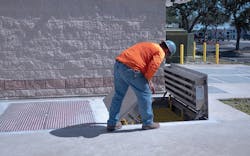Over time, the corrosive nature of wastewater took its toll on a pumping station in Seminole, Florida. Moisture and contaminants create highly corrosive conditions that attack metal and concrete structures, causing deterioration. Conditions are worse when the building is located in a humid, coastal environment, such as Seminole.
The degradation of system components left the community surrounding the pumping station confronting a revolting smell. “It’s vile. It’s absolutely disgusting,” said Brad Fayette, who worked at a nearby car wash in an interview with a local television station in 2017. “It’s like rotten eggs, really bad rotten eggs,” Kris Van Kirk told the television reporter. “It’s a stench so bad it will make your stomach turn.”
Pinellas County remedied the situation early in 2020 with the completion of a $2 million dollar, 13-month project in which it renovated the pumping station. The new three-part system includes an ozone polishing unit, biological trickling filter and carbon activation that will help keep odors from penetrating into the community.
Before revamping the pumping station, Pinellas County Utilities Engineering Section Manager Tom Menke said the county conducted extensive sampling to determine the precise chemical nature of odors that were filtering into the community. “One of the most well-known odors that everyone is aware of is hydrogen sulfide, which is the smell that people associate with rotten eggs,” Menke said. “But once you treat that, there may be some odors underneath that may come to the top.”
The underlying odors, called mercaptans, are a harmless but pungent-smelling gas made of carbon, hydrogen and sulfur. The pumping station in Seminole includes a unit that “polishes” the ozone layer, helping to reduce odors that might escape from the pumping station, especially mercaptans.
The erosion of floor doors at the pumping facility also contributed to the problem. “The existing doors did not close well,” said Jake Warren of TLC Diversified, whose company completed the system overhaul. “I was scared to walk on some of them because they were so corroded.”
The doors were replaced with 16 floor doors manufactured by BILCO. The aluminum doors allow access to wells, pumps and valves. Some of the doors were BILCO’s JD-AL H20 Doors, which are reinforced for AASHTO H-20 wheel loading. That feature allows heavy trucks and other industrial equipment to park on the door. Jeff Smith of Building Specialties in Bradenton worked on procuring the doors for TLC Diversified.
The new doors carry a 25-year warranty and are equipped with type 316 stainless steel hardware for superior corrosion resistance and BILCO’s patented lift assistance for easy, one-hand operation. BILCO’s doors are frequently specified in projects where there is a concern of water or other liquids entering the access opening.
The new system became operational in March 2020, clearing the air of the repulsive odors emanating from the pumping station. “I think this is a good solution, and I think it’s going to serve us well for the long haul,” Menke said.
Editor's Note: Scranton Gillette Communications and the SGC Water Group are not liable for the accuracy, efficacy and validity of the claims made in this piece. The views expressed in this content do not reflect the position of the editorial teams of Water & Wastes Digest, Water Quality Products and Storm Water Solutions.

